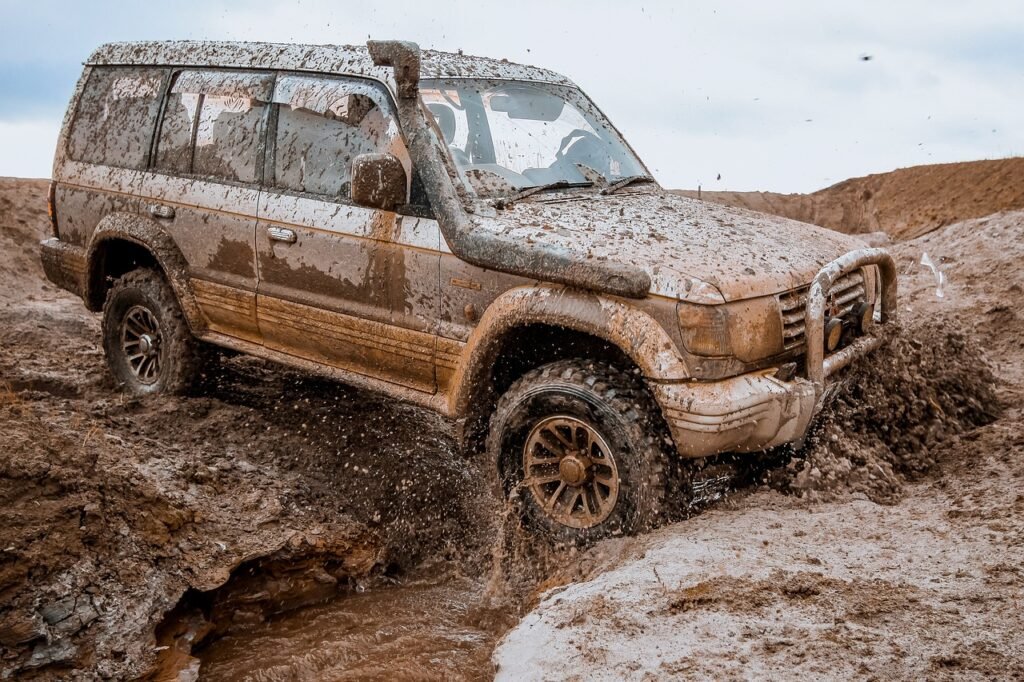Bug Out Vehicles (BOVs) play a crucial role in ensuring one’s preparedness for unexpected emergencies.
Whether it’s a natural disaster, civil unrest, or any other unforeseen event, having a reliable and well-equipped vehicle can be a lifeline.
In this article, we will explore the concept of Bug Out Vehicles, their significance in emergency preparedness, and the key factors to consider when selecting or preparing a vehicle for such scenarios.
As uncertainties become a part of our modern reality, understanding and planning for effective bug out strategies are more important than ever.
Table of Contents
Types of Bug Out Vehicles
In the realm of Bug Out Vehicles (BOVs), various options exist to suit different needs and preferences.
Understanding the types of vehicles available is crucial for making an informed decision about the best fit for your emergency preparedness plan.


A. Off-road vehicles
Features and Advantages
- Robust Suspension: Off-road vehicles are equipped with robust suspension systems, allowing them to navigate challenging terrains like dirt roads, rocky paths, and uneven landscapes.
- Four-Wheel Drive (4WD) Capability: The 4WD feature enhances traction and stability, enabling BOVs to handle diverse off-road conditions effectively.
- High Ground Clearance: Off-road vehicles often have higher ground clearance, allowing them to overcome obstacles and traverse rough terrain without getting stuck.
Examples
- Trucks: Larger trucks, especially those designed for off-road use, provide ample cargo space and towing capacity.
- SUVs: Sport Utility Vehicles are popular BOV choices due to their versatility, offering a blend of off-road capability and passenger comfort.
- ATVs (All-Terrain Vehicles): Compact and agile, ATVs are suitable for navigating tight spaces and reaching remote areas.
B. Modified vehicles
Customizations for Survival
- Armoring: Some BOVs undergo armoring to enhance protection against external threats, making them suitable for situations where security is a concern.
- Internal Modifications: Interior customizations may include storage solutions, sleeping arrangements, and integrated survival gear.
DIY vs. Professional Modifications
- DIY Modifications: Enthusiasts may choose to modify their vehicles themselves, tailoring the features to their specific needs and budget.
- Professional Modifications: Specialized companies offer professional BOV modifications, ensuring a high level of expertise and compliance with safety standards.
Understanding the distinctions between off-road vehicles and modified vehicles is essential for aligning your Bug Out Vehicle with your unique preparedness requirements.
Whether you prioritize off-road capabilities, customization options, or a combination of both, selecting the right type of BOV lays the foundation for a reliable emergency escape plan.
Essential Features for Bug Out Vehicles
When preparing a Bug Out Vehicle (BOV), certain key features are essential to ensure optimal performance and readiness during emergency situations.
Consider these factors to enhance the functionality and reliability of your chosen vehicle.


A. Durability and Reliability
- Robust Engine: A dependable engine is crucial for consistent performance under stress. Regular maintenance and choosing a vehicle with a reputation for durability are vital considerations.
- Sturdy Construction: Look for vehicles with strong, durable frames and components capable of withstanding the rigors of off-road travel.
B. Storage and Cargo Capacity
- Ample Cargo Space: BOVs should offer sufficient cargo space to accommodate essential supplies, including food, water, first aid kits, and survival gear.
- Organized Storage Solutions: Incorporate storage solutions such as drawers, compartments, and racks to keep supplies organized and easily accessible.
C. Fuel Efficiency and Alternative Fuel Options
- Fuel Efficiency: While fuel efficiency is important, it’s also crucial to strike a balance with the vehicle’s overall capabilities. Consider vehicles that offer a good compromise between fuel economy and performance.
- Alternative Fuel Sources: Exploring alternative fuel options, such as biodiesel or propane, can be beneficial for long-term sustainability, especially when traditional fuel sources may be scarce.
Selecting a Bug Out Vehicle with a focus on durability, ample storage, and fuel considerations ensures that your vehicle is well-equipped to handle the challenges of emergency situations.
By prioritizing these essential features, you enhance your ability to navigate and respond effectively in times of crisis.
Gear and Equipment for Bug Out Vehicles
Equipping your Bug Out Vehicle (BOV) with the right gear and equipment is essential for ensuring preparedness and resilience in emergency situations.
Consider the following categories when outfitting your vehicle for optimal functionality during crises.


A. Emergency Supplies
- Water and Food: Carry a sufficient supply of potable water and non-perishable food items to sustain yourself and your passengers for an extended period of time.
- First Aid Kit: Include a well-stocked first aid kit containing essential medical supplies and medications to address injuries and health concerns.
- Shelter: Pack lightweight and portable shelter options, such as tents or emergency blankets, to provide protection from the elements.
B. Communication Tools
- Two-Way Radios: Ensure reliable communication with two-way radios to stay connected with your group or receive updates on the situation.
- Emergency Radio: Include a weather-resistant emergency radio to stay informed about changing conditions and receive emergency broadcasts.
C. Navigation Systems
- GPS Devices: Equip your BOV with GPS devices to navigate unfamiliar terrain accurately.
- Maps: Carry physical maps as a backup, especially in areas with limited or no GPS signal.
D. Maintenance Tools and Spare Parts
- Basic Tools: Include a toolkit with essential tools for vehicle maintenance and repairs.
- Spare Parts: Carry spare parts such as belts, hoses, and fuses to address common mechanical issues on the go.
By carefully selecting and organizing emergency supplies, communication tools, navigation systems, and maintenance essentials, you enhance the overall preparedness of your Bug Out Vehicle.
This ensures that you have the necessary resources and capabilities to navigate, communicate, and address potential challenges effectively during emergency situations.
Choosing the Right Bug Out Vehicle
Selecting the appropriate Bug Out Vehicle (BOV) is a critical decision that depends on various factors, including personal preferences, location, budget constraints, and the intended use of the vehicle.
Consider the following key aspects to guide you in choosing the right BOV for your emergency preparedness plan.

A. Consideration of Personal Needs and Location
- Geographic Considerations: Assess the terrain of your likely evacuation routes and surrounding areas to determine the level of off-road capability required.
- Passenger Capacity: Consider the number of people your BOV needs to accommodate, ensuring there is ample space for passengers and their belongings.
B. Budget Considerations
- Initial Purchase Cost: Evaluate the upfront cost of the vehicle, factoring in any modifications or customizations you plan to make.
- Operating and Maintenance Costs: Estimate ongoing expenses, including fuel, maintenance, and insurance, to ensure your BOV remains cost-effective in the long run.
C. Long-Term Sustainability and Maintenance
- Availability of Parts: Choose a vehicle with readily available and affordable spare parts to facilitate maintenance and repairs.
- DIY Maintenance vs. Professional Services: Assess your ability and willingness to perform maintenance tasks yourself or rely on professional services, considering the vehicle’s complexity.
Making an informed decision about the right BOV involves a careful balance between your specific needs, financial considerations, and the long-term sustainability of the chosen vehicle.
By addressing these factors, you can ensure that your Bug Out Vehicle aligns with your emergency preparedness goals and provides a reliable means of transportation in times of crisis.
Maintenance and Preparedness
Maintaining a Bug Out Vehicle (BOV) in optimal condition is crucial for ensuring its reliability during emergency situations.
In addition to regular maintenance, incorporating preparedness measures and conducting periodic drills contribute to a well-rounded approach to emergency planning.


A. Regular Vehicle Maintenance
- Scheduled Inspections: Adhere to a regular schedule for vehicle inspections, checking essential components such as brakes, tires, fluids, and the engine.
- Fluid Checks and Changes: Regularly check and change fluids, including oil, coolant, and brake fluid, to prevent mechanical issues and ensure smooth operation.
- Tire Maintenance: Monitor tire pressure, rotate tires, and replace them when necessary to maintain traction and stability.
B. Emergency Drills and Simulations
- Evacuation Drills: Conduct simulated evacuation drills to familiarize yourself and passengers with the BOV’s features and practice efficient loading and unloading of supplies.
- Mechanical Troubleshooting: Practice basic mechanical troubleshooting scenarios to enhance your ability to address common issues that may arise during emergencies.
C. Keeping Supplies Up-to-Date
- Regular Inventory Checks: Periodically review and update the emergency supplies in your BOV, ensuring that food, water, medications, and other essentials remain within their expiration dates.
- Technology and Communication Updates: Stay current with technological advancements by updating communication devices and navigation systems to maintain reliable connections and accurate information.
By prioritizing regular maintenance routines and incorporating preparedness drills, you not only extend the lifespan of your Bug Out Vehicle but also enhance your ability to respond effectively in emergency situations.
The combination of vehicle reliability and preparedness measures ensures that your BOV remains a dependable asset when needed most.
Conclusion


In conclusion, Bug Out Vehicles (BOVs) stand as crucial assets in the realm of emergency preparedness, offering individuals a means to navigate and respond effectively to unforeseen events.
The journey through understanding and selecting an appropriate BOV involves considering various factors, from the vehicle’s type and essential features to personal needs and long-term sustainability.
In your pursuit of a Bug Out Vehicle, prioritize regular maintenance, conduct preparedness drills, and keep your supplies up-to-date to ensure peak operational performance when it matters most.
Remember, the right BOV is not just a mode of transportation; it is a lifeline that can make a significant difference in your ability to safely navigate and overcome challenges during critical times.
In the face of uncertainty, investing time and consideration into your Bug Out Vehicle is an investment in your safety and that of your loved ones.
I hope that the information you learned from this article and your choice of BOV will help create a more resilient and safe future.

